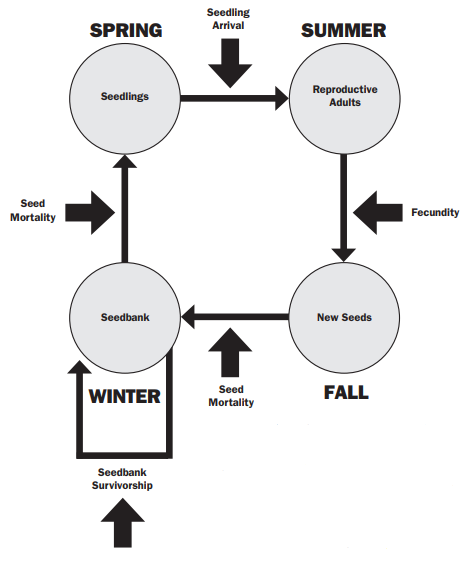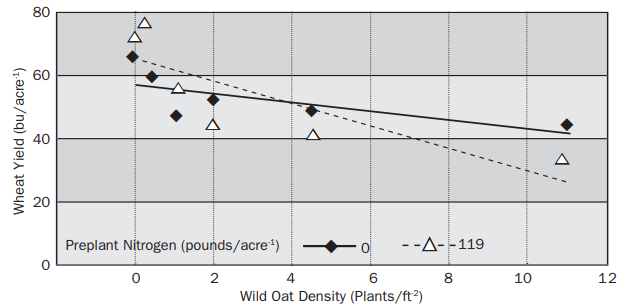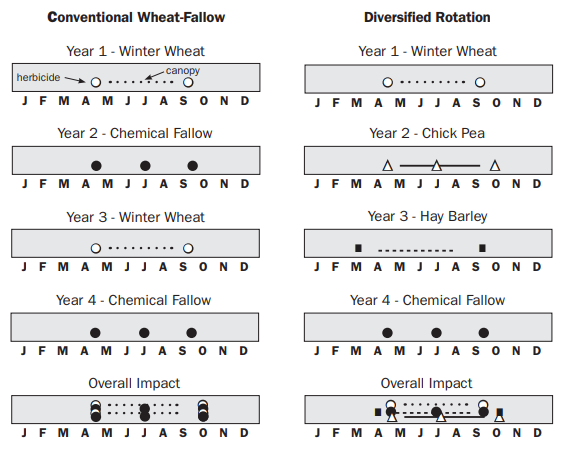
Integrated strategies for managing agricultural weeds: making cropping systems less susceptible to weed colonization and establishment
This Montguide gives you detailed information on how to design a weed control program that relies more on management techniques and less on herbicides and tillage. Find out how integrating biological, cultural, mechanical and chemical practices can help reduce the colonization, establishment and impact of weeds on your crops.
Last Updated: 03/12by Richard G. Smith and Fabián D. Menalled, Department of Land Resources and Environmental Sciences, Montana State University
CURRENTLY, MOST STRATEGIES AIMED AT
reducing the abundance of agricultural weeds involve herbicide applications and/or mechanical disturbance (i.e. tillage). Although these approaches have been successful in increasing farm labor efficiency and crop productivity, concerns regarding the economic and environmental impacts of these weed control practices and the development of herbicide resistance have generated interest in identifying alternative weed management approaches. An integrated approach to weed management (Integrated Weed Management) can be used to develop agricultural systems that are less dependent on herbicides and tillage. In this guide we discuss shifting the focus from weed control to weed management and how the integration of biological, cultural, mechanical and chemical practices can help reduce weed colonization, establishment and impact.
What are weeds and why are they so successful?
What is a weed, really? The most common definition of a weed is a plant growing where it is not wanted. This definition has driven most weed science research and weed control practices for the past 50 years. More recently, weed scientists have recognized that weeds are plants that are especially successful at colonizing and maintaining their abundance under conditions of repeated disturbance. Under this definition, weeds are perceived as plants that possess adaptive characteristics which allow them to invade, survive and reproduce in cropping systems.
From Weed Control to Weed Management
Weed control and weed management are not synonymous. Weed control refers to actions used to achieve the immediate elimination of an existing weed population, usually through the use of herbicides and tillage. Weed management goes beyond control of existing weed problems and focuses on reducing weed invasion and emergence, preventing weed reproduction, and minimizing weed competition with crops. Thus, while weed control reacts to problems after they occur, weed management emphasizes understanding the causes of weed problems with the goal of preventing weeds from becoming problematic in the first place.
Characteristics of weeds that favor their establishment and reproduction in cropping systems
| Establishment Phase | Regeneration Phase |
| Germination and emergence over a range of environmental conditions | Can self-fertilize or regenerate vegetatively |
Rapid growth |
Abundant and continual seed production under favorable conditions |
| Highly competitive for nutrients and water | Polymorphic seeds, often resistant to animal digestion |
| Mature plants can tolerate a wide range of environmental conditions | Seeds can remain viable for an extended period, often with pronounced dormancy |
What is Integrated Weed Management?
Integrated weed management (IWM) combines the use of biological, cultural, mechanical and chemical practices to manage weeds, so that reliance on any one weed management technique is reduced. The main goals of an IWM program are to: 1) use preventive tools to maintain weed density at a level that does not harm the crop; prevent shifts towards more difficult to control weeds; and 3) develop agricultural systems that maintain or improve crop productivity, farm revenues, and environmental quality. Thus, designing a successful IWM program requires understanding the different biological and ecological factors that influence the short-, mid-, and long-term dynamics of weeds in agricultural settings.
Principles of IWM
The following five principles should be kept in mind when designing IWM programs that are effective at reducing the opportunities for agricultural weeds to establish and become problematic.
- Prevention is key
- Increase natural weed mortality
- Don’t feed the weeds
- Keep weeds off balance
- Use as many “little hammers” as possible
1. Prevention is key. Limit seed introduction, production and dispersal.
Preventing weeds from establishing in the first place is perhaps the most effective way to minimize weed problems in your crop fields. Using certified seeds and cleaning farm equipment after use in an infested field are two simple sanitation practices that prevent weeds from entering or spreading through fields. Removing weeds before they produce seeds, either through spot spraying, tillage or mowing, and collecting weed seeds in chaff wagons pulled behind the combine can also help reduce the spread of weeds within and among fields.
2. Increase natural weed mortality. Enhance the abundance and effectiveness of natural enemies of weeds
During the life cycle of a weed, many mortality factors threaten its survivorship (Figure 1, page 3). Since it is unlikely that all weeds can be prevented from establishing in your fields, it is important to maximize the effectiveness of the mortality factors that exist naturally within your field. For example, studies have shown that weed seeds that are not protected by burial in the soil are more prone to be destroyed by ground beetles, mice, fungi, bacteria or desiccation (Figure 2, page 3). Maximizing the magnitude and impact of these mortality factors can be an important component of a successful IWM program.
3. Don’t feed the weeds. Maximize resource use by crops.
Crops and weeds compete for the same basic resources: sunlight, nutrients, water and space. A key component in the design of a successful IWM program is to make sure that these resources are captured by the crop and not by the weeds (Figure 3, page 3). Several practices can help ensure that your crops have the advantage. Here are just a few:
- Apply fertilizer appropriately. Banding fertilizer near the crop row and applying it at the appropriate time enhances the ability of a crop to compete with weeds. For example, band placement of fertilizer in the root zone has been shown to increase early plant growth and grain yield, and decrease weedy grass populations. These effects are particularly pronounced in reduced tillage cropping systems.
- Adjust planting densities and row widths. Decreasing row spacing and/or increasing seeding rates enhances the competitiveness of the crop relative to the weeds (particularly early in the growing season) so that fewer resources are available to support weed growth. Research showed that wild oat seed production decreased as barley seed rate increased from 67 to 156 lbs/acre (75 to 175 kg/ha).
- Utilize competitive crops and cultivars. Crops differ in their ability to compete against weeds. For example, cereal crops such as barley are more competitive against weeds than pulse crops such as lentils. Within cereals, winter barley is more competitive than winter wheat. Moreover, within crop species varieties differ in their ability to compete for resources and suppress weed growth. As a general rule, tall varieties with high leaf area have been shown to be more competitive than short varieties with low leaf area. Crop and variety selection should be based on balancing weed suppression needs with the potential for high grain yields. For example, an analysis of 13 winter wheat cultivars found that there was a 40 percent yield difference between the two most weed-suppressive cultivars.
- Use high quality seeds. The use of higher seeding rates and larger seed size classes has been shown to improve spring wheat competitive ability with wild oat and increase economic returns.
Preventing seed production and dispersal reduces the spread of weeds across fields. A case study: Wild oat
| Limit seed production | Limit seed dispersal |
| Wild oat is usually found in patches. Minimizing seed production can reduce patch expansion. For example, a six-year study monitored wild oat patch expansion in farmers’ fields. Wild oat patches that were treated to prevent seed production anddispersal increased by 35 percent; while untreated patches increased by 330 percent. | Wild oat seeds are heavy and do not disperse more than six to nine feet from the parent plant. However, seeds can be moved long distances (more than 450 feet) when taken up by a combine harvester and returned to the ground with chaff. Methods that reduce seed dispersal during har- vesting operations can reduce the spread of wild oats within and across fields. For example, chaff collection removes up to 74 percent of wild oat seeds that would otherwise be dispersed by the combine. |

FIGURE 1. Life cycle of summer annual weeds such as kochia, wild oat, common lambsquarters or green foxtail. Plants germinate in the spring, produce seeds in late summer and fall, and spend the winter as seeds in the seedbank. The wide arrows indicate transitions in life stages where natural mortality factors can impact weed survival. Destruction of weed seeds by predators, patho- gen attack and reduction in seedling recruitment have all been shown to significantly impact weed abundance.

FIGURE 2. Carabid beetles such as Harpalus pensylvanicus are common in many crop fields and can eat and destroy large numbers of weed seeds. Natural enemies of weeds are often present naturally in crop fields; however, their abundances can be enhanced by maintaining a diverse plant community in and around crop fields.

FIGURE 3. The impact of wild oats on wheat grain yield increases with nitrogen. In competition, wild oat is better able to use added nitrogen than wheat, thus gaining a competitive advantage and decreasing crop yields. It is therefore important to insure that fertilizer applications target the crop, not the weeds (Adapted from Carlson H. and J. Hill, 1986, Weed Science 34: 29-33).
4. Keep weeds off balance - don’t let the weeds adapt to your weed management practices.
Using the same crop rotation over and over again generates predictable environmental conditions that are exploited by weeds. For example, jointed goat grass thrives in winter wheat-fallow rotations because it has growth requirements that are very similar to winter wheat. Likewise, early germinating weeds such as wild oat can be found in early seeded cereals, and late germinating species such as pigweed can be a problem in late seeded canola.
Growers can decrease the opportunities for weeds to establish and persist by ensuring that their cropping systems are unpredictable and inhospitable environments for weeds. Crop rotation is a powerful tool for disrupting weed life-cycles and helps delay the development of herbicide resistance. Rotating crops means that different resources are utilized at different times during the season and over the course of several years. This makes it difficult for weeds to adapt to all of the different conditions likely encountered over the entire rotation. For example, wheat and peas are generally sown as early as possible, while canola is usually planted later to avoid spring frost. Not only is the predictability of the herbicides associated with each crop lower in a diversified rotation, which can delay the selection of herbicide resistant biotypes, but changing the seeding date from year to year means that specific weeds cannot adapt to the changing environmental conditions (Figure 4, below). For more information, see MontGuide MT200506AG, Preventing and Managing Herbicide-resistant Weeds in Montana.

FIGURE 4. Conventional and diversified rotations differ in the type and timing of herbicide applications (symbols), seeding dates and canopy closure times (lines). In the diversified rotations, the continuous variations in herbicides, canopies and seeding dates makes it very difficult for a specific weed to adapt to the changing environmental conditions.
5. Use as many “little hammers” as possible to achieve maximum long-term weed management Conventional cropping systems tend to rely on one or two “large hammers”, such as herbicides and tillage, for weed management. These practices provide short-term control of weeds. Unfortunately, over the longer-term these “large hammers” are not entirely effective because weeds are able to adapt to their predictability. Instead of a few large hammers, growers can employ multiple management practices (many little hammers), such as adjusting seeding rates, directed nutrient placement, crop rotation, and enhancement of natural weed mortality factors to manage weeds.
There is growing evidence supporting the merits of combining several different weed management practices. For example, studies conducted in Canada found that in rotations containing wheat, barley, canola and field pea, early crop seeding (April rather than May), higher crop seed rates, and spring-applied fertilizer in conjunction with timely but limited herbicide use led to effective management of weeds and high crop yields.
Summary
Weeds are well adapted to colonize and establish in agricultural fields. An integrated approach to weed management focuses on making cropping systems less favorable to weeds through the use of biological, cultural, mechanical and chemical practices to manage weeds. A well planned rotation will incorporate many of the management practices covered in this MontGuide and allow you the opportunity to increase the diversity and effectiveness of stress and mortality factors that impact weed colonization and establishment. By incorporating an integrated approach to weed management you can achieve effective long-term weed suppression with decreased reliance on herbicides and tillage.
Additional Readings and Web Sites
Liebman, M., C. Mohler and C. Staver. 2001. Ecological Management of Agricultural Weeds. Cambridge University Press.
Booth, B., S. Murphy, and C. Swanton. 2003. Weed Ecology in Natural and Agricultural Systems. CABI Publishing
Crop Adviser Institute: http://www.cai.iastate.edu/
Western Region Sustainable Agriculture Reseaarch and Education (WSARE): http://wsare.usu.edu
Integrated weed management in vegetable crops: http://www.aces.uiuc.edu/ipm/fruits/iwm/iwm.html
Integrated weed management options for noxious weeds: http://www.state.sd.us/doa/das/IWM.html
University of California Pest Management Guidelines. Integrated weed management in orchards: http://www.ipm.ucdavis.edu/PMG/r583700111.html
Not all crop varieties are equally effective in suppressing weeds. Several traits can make some crop varieties more competitive than others.
Seedling establishment
- Large average seed weight
- Rapid seedling emergence
- High seedling growth rate
Canopy characteristics
- Rapid leaf area expansion and canopy closure
- Dense canopy maintained over time
Nutrient use
- Rapid and efficient nutrient uptake
Plant height and growth form
- Tall plants
- Indeterminate growth habit (crop continues to grow taller throughout the summer)
(adapted from Callaway, M.B. 1992. American Journal of Alternative Agriculture 7: 169-180)
To order additional publications, please contact your county or reservation MSU Extension office, visit our online catalog at www.msuextension.org/store or e-mail orderpubs@montana.edu

